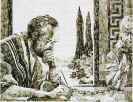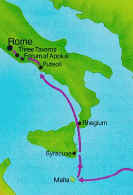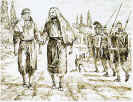The Bible: Apostles and Epistles
The first Christians were Jews. But as Christianity spread, it reached people in the Greek and Roman world and introduced them to the Holy Scriptures.
One of the church’s hardest challenges was to accept the growing number of non-Jewish converts. At first it was hard even for some of the apostles to grasp that this new faith transcended their national, religious and cultural heritage. But God made this obvious through the work of Peter and Paul (Acts 10:34-35). By the middle of the first century, Christianity had reached as far as Rome.
The church in Rome had Jewish and gentile converts, and in his Epistle to the Romans Paul admonished them all. “All have sinned and fall short of the glory of God” said Paul (Romans 3:23). Christ is the Savior of all, Jews and Gentiles, who put their trust in him (Romans 3:29-30).
The first and second epistles to the Corinthians were written by Paul to the church at Corinth, a major cosmopolitan center in Greece. Paul had to instruct the Corinthian Christians about recognizing various forms of sin (1 Corinthians 5:1-2). Paul instructed and corrected in love, with deep concern for the young church. The 13th chapter of 1 Corinthians is sometimes called the “love chapter” because of its eloquent description of pure Christian behavior (1 Corinthians 13:4-7).
In the Epistle to the Galatians Paul admonished the new converts to stand fast in the gospel (Galatians 5:1). Faith in Christ did not mean that believers had to keep Jewish laws like circumcision (Galatians 3:26-29).

Even in prison, Paul wrote to the churches under his care. |
Ephesians Ephesians was written to the church at Ephesus, the capital of the Roman province of Asia. References to Ephesus in the books of Acts and Revelation testify of the importance of this city (Acts 19, Revelation 2:17).
Philippians Philippians is a warm and personal letter of thanks to the first church Paul established on the continent of Europe. In this epistle, Paul expressed his appreciation for their monetary gift and encouraged them to remain faithful in the face of adversity (Philippians 2:3-4).
In the Epistle to the Colossians, Paul warned the believers to resist the wrong ideas and practices that infiltrated the church in that region. Angel worship and ascetic practices were robbing Christians of the purity of the gospel. Paul stressed that Christians were complete in Jesus Christ,“who is the head over ever power and authority” (Colossians 2:8-10).
Christ’s return was a main theme of Paul’s two letters to the church in the city of Thessalonica. In 1 Thessalonians Paul reminded the people to be ready for that event (1 Thessalonians 5:2-4). But some members began to abandon their routine responsibilities in anticipation of Christ’s immediate return. In 2 Thessalonians Paul reminded them to wait for Christ in a productive and law-abiding way (2 Thessalonians 3:11-13).
  |
| Paul’s preaching had taken him throughout much of the Roman world. His first journey is marked in red, the second in blue, the third in yellow, and the fourth in purple. |
The next three epistles, 1 and 2 Timothy and Titus, are known as the pastoral epistles. They were written to ministers whom Paul had given charge over local congregations. These letters contain advice on church administration and the qualifications and duties of church leaders (1 Timothy 3:2-5).
The short Epistle to Philemon is a personal letter from Paul to a member of the church in Colossae concerning a slave who had run away. This little book provides an interesting glimpse into first-century society and is a good example of how Christians should treat one another.
Next you’ll come to the Epistle to the Hebrews. The contents of the letter suggest that it was directed to Christians of Jewish background. The early church was still greatly influenced by the customs of the Jewish faith. This book helped the church to see how the old covenant, with all its rituals, types and symbols, looked forward to fulfillment in Jesus Christ (Hebrews 12:28).
 Roman roads facilitated the spread of the Christian gospel. Roman roads facilitated the spread of the Christian gospel. |
The next five books are known as general epistles. They were written to the church in general, rather than to individual congregations. James is an expressive book about practical Christian living (James 1:27).
The epistles of Peter were written to the church during a period of persecution. They offer encouragement to Christians to look forward in hope (1 Peter 1:6-7).
The three epistles of John also encourage Christians to remain steadfast in their faith. They were written several decades after Jesus had returned to heaven. As the years passed, false teaching began to affect the churches. These epistles were written at a time of great tension and strain in the church, and they capture the urgency of the situation (1 John 2:18-19).
The final epistle, Jude, is a fitting close to these letters. It is a reminder that in spite of the trials and tribulations that the Christian church was suffering, its faith and patience would be rewarded (Jude 24-25).
Now we come to the last stop on our tour, the Apocalypse or Book of Revelation. Many people consider this to be the most enigmatic book in the Bible. Indeed, the colorful, glorious and often horrific visions, numbers, symbols and characters of the book of Revelation paint a complex and awe-inspiring panorama of the ultimate fulfillment of the purpose of God, including the events leading up to Christ’s return and hints about what lies beyond, into eternity, for the saved people of God.
Revelation concludes with the promise that Jesus will return and complete the work of salvation (Revelation 22:20).
Come Again Soon!
The amazing book we know as the Bible begins with God and humanity in harmony in a beautiful garden. And after the astounding spectacle of human history that is described thereafter, the book ends with God and humans in harmony in a beautiful garden setting where the living waters of eternal life are freely available.
The Bible, in short, chronicles the story of God saving humans from the ill-advised odyssey they undertook by departing from God. The story ends with the assurance that all human beings, made in the image of God, will learn to live in peace and harmony with God and with each other. Humans will then live in eternity with God.
On this note, we end this tour of the Bible. You have made a valuable start in getting to know the Scriptures. Do you still have questions? You should. We have barely scratched the surface. As we told you before we began, there is a lifetime of study in these pages.
Remember that the Bible is a challenging book. You can’t expect to understand everything all at once. Its contents will make you think and cause you to consider what you believe and how you live. As Paul wrote to Timothy, “All Scripture is God-breathed and is useful for teaching, rebuking, correcting, and training in righteousness” (2 Timothy 3:16). There is enormous power in these books of the Bible. They can change your life, if you let them. But that is a decision you must make for yourself.
We hope this guided tour has helped make the Bible a more interesting and valuable book and inspired you to continue studying it. Thank you for coming along!
This article was written in 1991, and updated in 2001.
A related article: Do We Have the Right Books in the Bible?
Author: John Halford

